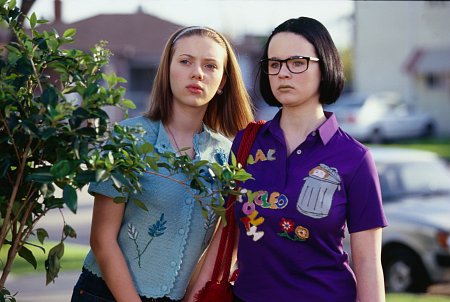« Memento (2000) – Movie Review | Home | About Schmidt (2002) – Movie Review »
Ghost World (2001) – Movie Review
By Robert L. Jones | August 14, 2001

Scarlett Johansson and Thora Birch are up to mischief in "Ghost World"
Every Cynic Is a Frustrated Romantic
[xrr rating=4.5/5]
Ghost World. Starring Thora Birch, Scarlett Johansson, Steve Buscemi, Brad Renfro, Illeana Douglas, Bob Balaban, Stacey Travis, Charles C. Stevenson, Jr., Dave Sheridan, Tom McGowan, Debra Azar, Brian George, and Pat Healy. Cinematography by Alfonso Beato, A.S.C. Edited by Carole-Kravetz-Aykanian and Michael R. Miller. Music by David Kitay. Screenplay by Daniel Clowes and Terry Zwigoff, based on the graphic novel by Daniel Clowes. Directed by Terry Zwigoff. (United Artists Pictures/Metro-Goldwyn-Mayer, 2001, Color, 111 minutes. MPAA Rating: R.)
Ghost World is the best movie I’ve seen in a long damn time. The key to a great movie is that it’s its own world—a self-contained universe. Bringing Up Baby is one such example, so is On the Waterfront and For a Few Dollars More. Any of Billy Wilder’s movies, too. This one was one of them.
I love Enid, played by Thora Birch. A teenage H.L. Mencken, she skewers pretentious poseurs and tips over sacred cows. But, underneath her outer punk persona, there is a soft-hearted hero-worshipper. Her predicament is that she’s stranded on a social desert island and uses cynicism as a shield to protect her from the hopeless banality in which heroes and passion are deemed passé by those who walk through life questioning nothing, but just parroting the answers they’ve picked up from the larger society.
Ghost World abounds in social commentary, but doesn’t fall into the schmaltzy trap of trying to “solve” the world’s social ills. Although on the surface Enid is directionless, she nonetheless has a mania for sketching a diary of the oddballs and weirdoes that make up her small town. An excellent artist and caricaturist, Enid ends up failing art class twice.
Her airhead/hippy/burnout art teacher, Roberta (Illeana Douglas), is a walking cliché of a total conformist affecting an air of anti-authoritarianism. She blows off Enid’s diary and her cartoons of Don Knotts, but pushes her students to instead produce so-called “controversial” art. A really dead-on scene is when one of Roberta’s sycophantic students (Ashley Peldon) creates a sculpture out of coat-hangers, which represents “a woman’s right to choose, something I feel super-strongly about.” It’s a gem of a parody on political art in which the politics are much stronger than the art. I was rolling on the floor when Roberta’s real bad college art film “Mirror/Father/Mirror” clip was playing. God damn, that rings true. Roberta doesn’t encourage the artistic impulse so much as pushing her agenda on the students to be “controversial” and “confront people’s attitudes,” mainly because she has no original ideas of her own.
So, Enid decides to spoof Roberta and bring in a “found object” of a Jim Crow caricature from the 1920s of “Coon’s Chicken,” which depicts a monkey-like negro. This pisses off the other students (who were sotto voce receiving the message that they should only confront people with politically correct controversy), but the irony of the movie is in how Roberta reacts to the Jim Crow poster; Enid can’t get the time of day from her when it comes to her own talented artwork, but her jokes on Roberta’s inanities wins Roberta over to her cause and even inspires Roberta to get Enid a scholarship to art college. All this falls apart when Roberta enters the piece in an exhibit, and the local busybodies force her to remove the poster and fail Enid in her class. Roberta’s capitulation reveals her devotion to “controversy” and “confrontation” to be a hollow pose, and she covers her ass by letting Enid be the lamb to the slaughter.
The relationship between Enid and Seymour (Steve Buscemi) evinces Enid’s yearnings to find someone to look up to, rather than down upon. I liked Steve Buscemi’s performance a lot. I’m so used to him playing funny roles, that it was sort of incongruous seeing him play it (mostly) straight in a comedic movie, but it worked quite well. Like Enid, Seymour is an outcast, but middle-aged, and at first becomes the victim of one of Enid’s and her best friend Rebecca’s (Scarlett Johansson) cruel pranks. But underneath the nerdish and pitiful exterior, Enid comes to discover in Seymour someone as isolated and alienated from society as she is. She finds in him a noble soul, whose passions are worn less on his sleeve than Enid’s are, but locked up in his 1920s-themed room dedicated to his 78 rpm blues and ragtime records and poster art from the same era. Enid sees in Seymour a lot of herself, but also someone who has been run over once too many times in life, and whose social rebellions have shriveled into repressed loneliness. Enid finds in Seymour a hero, and gushes, “I’d kill for a room like yours.” complimenting his passion for nostalgia. To which Seymour—who has given up on the possibility of ever fitting in or finding love— replies, “go ahead, kill me.”
By the movie’s end, Seymour starts asserting his inwardly pent-up feelings to relate to the world through his romance with Enid. He finally getting up the nerve to break up with Dana (Stacey Travis), a nice, though conventional woman, in order to be with Enid, who shares his passions, and thinks like he does. Seymour nonetheless has his love for Enid somewhat unrequited. Just as the revelation that Seymour deserves happiness manifests itself, Enid alienates herself from the world—and the two people she most treasured, Seymour and Rebecca. A happy ending does not win the day, because Enid is compelled to travel down the same lonely path that Seymour has. Perhaps in twenty years, she will have become what he is now.
So, what’s the moral of Ghost World? It’s to go after your passions. The movie’s tragedy is its observation that all-too-often while one may realize his own true self, another puts hers away in hiding. A fine line separates the benevolent universe and the malevolent, and that place is what the authors meant by the movie’s title.
Robert L. Jones is a photojournalist living and working in Minnesota. His work has appeared in Black & White Magazine, Entrepreneur, Hoy! New York, the New York Post, RCA Victor (Japan), Scene in San Antonio, Spirit Magazine (Canada), Top Producer, and the Trenton Times. Mr. Jones is a past entertainment editor of The New Individualist.
Topics: Buddy Movies, Comedies, Graphic Novel Adaptations, Independent Films, Movie Reviews | Comments Off on Ghost World (2001) – Movie Review
